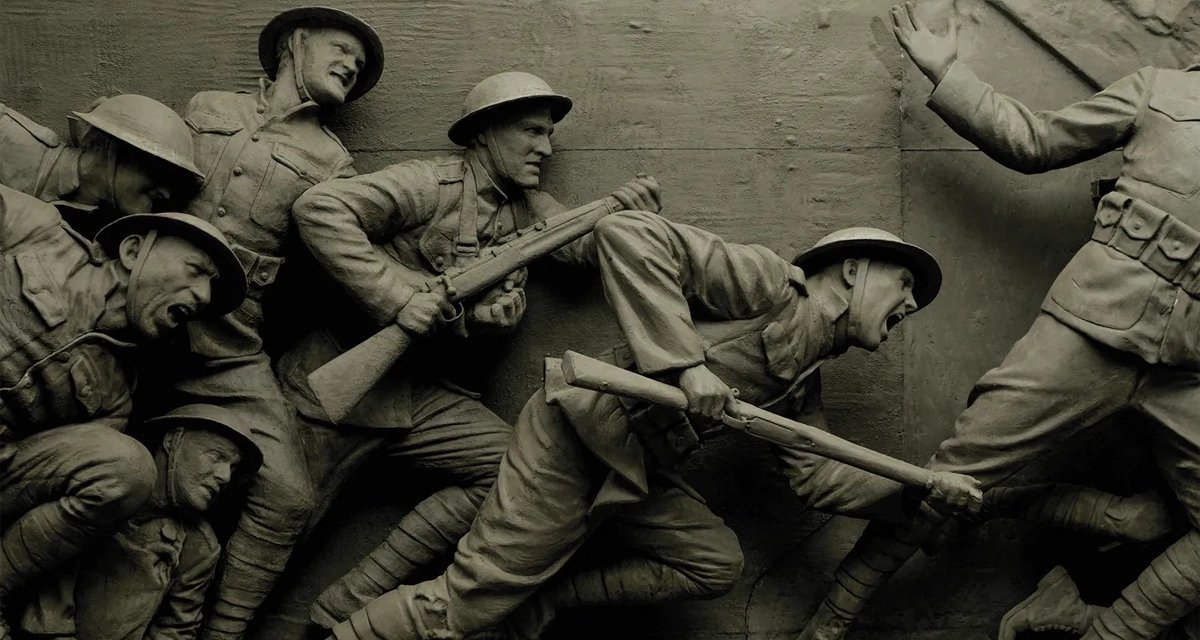world war I
World War I was one of the largest and most influential wars in history. This war started in 1914 and lasted until 1918. This war was originally a battle between two alliances in the world. The first group was the allied coalition, which included the countries of France, England, Russia, Italy, and America, and the other coalition, which is known as the central coalition, included the countries of Germany, Austria-Hungary, Ottoman, and Bulgaria.
Several reasons led to the outbreak of the First World War, some of which will be mentioned below.
One of the main reasons for the outbreak of the First World War for some countries in the world was the organization under colonial rule and the development of countries in search of a better geopolitical and economic position. So that some countries were looking for more benefits and in order to colonize the countries, to look for their economic interests, to use the third world countries as a colony and a way to loot the wealth, resources and mines of these countries. to provide their own resources.
Among the other reasons for the desire of countries to participate in World War I was the imperialist competition between the great European powers and their efforts to divide the territories so that each country sought the territory that would provide the most economic and commercial benefits for it.
At first, the sparks of the start of the world war were sparked in Europe and among some European powers.
World War I began with the escalation of fighting on European lands and then turned into a widespread world war. Important battles took place in Europe, such as the battles of Verdun, Marne, Gallipoli, and Soum, which were more important among other battles that took place. On the other hand, Churchill’s battle in West Africa and plans to destroy the enemies in the Persian Gulf region are separated from the First World War and are known as sub-wars.
The First World War caused the death of millions of people and resulted in major effects such as the change of borders and the fall of empires. This war caused the emergence of new republics in the world and was also a prerequisite for the start of World War II.
This war caused political crises in parts of Austria-Hungary and the Ottoman Empire. The occurrence of numerous political crises in these regions caused the division of these two countries into several countries.
The disintegration of the Ottoman Empire
The disintegration of the Ottoman Empire in World War I was one of the important consequences of this war. The Ottoman Empire, which at the beginning of the 20th century was still considered one of the largest empires in the world, faced numerous allies in this war, such as England, France, and Russia.
Initially, the Ottoman Empire was allied with Germany and Austria-Hungary in World War I. But in the following years, due to the lack of victories of these allies and the weakening of the Ottomans in areas such as the Caucasus, Egypt, and Arabia, the Ottoman Empire’s military forces were severely defeated and retreated from facing the allied forces.
After stopping the Ottoman attacks on the eastern and southern fronts, the allied forces were gradually able to capture areas of the Ottoman Empire. Finally, in 1918, due to repeated defeats and military and economic pressures, the Ottoman Empire reached a crisis in the First World War.
After the end of the war, the Allies together with the Allies started plans to divide and divide the Ottoman Empire. This process was recognized by the agreement of great powers such as England, France and Italy at the Versailles Peace Conference in 1919. Thus, the Ottoman Empire became a smaller empire called Turkey, and large parts of Ottoman lands were occupied by the Allies. According to the Sotern Peace Treaty, Turkey’s borders were determined and some Ottoman territories became independent. Also, in the regions where different ethnicities were settled, they were given the ability to form independent governments. This division resulted in the formation of independent empires such as Turkey, Syria, Lebanon, Iraq and Jordan.
Therefore, the disintegration of the Ottoman Empire in the First World War caused the defeat and weakness of the Ottoman Empire and the emergence of new countries in the areas that were previously under the Ottoman rule.
The disintegration of the Soviet Union in World War I
The disintegration of the Soviet Union was done in different ways due to the First World War. Initially, movements for independence and separation from the Soviet Union emerged in some regions. Then, during the war, the weakening of the tsarist and communist regime in the Soviet Union due to economic and military crises, public discontent and the advance of opposing armies (especially the White Forces and foreign forces) led to the formation of independent republics and the disintegration of the Soviet Union.
During World War I, the Soviet Union was one of the Allied Powers at war with the Central Powers. But economic crises, lack of resources, lack of food and facilities, administrative corruption, internal political disputes and external pressures led to the collapse of Soviet power.
In 1917, the October Revolution took place in Soviet Russia and the tsarist regime fell. This revolution was supported by the Bolsheviks led by Vladimir Lenin and the Russian Soviet Republic was established. With the formation of the Russian Soviet Republic, the pressures for secession of regions such as Ukraine, Belarus and Kazakhstan increased.
Then, in 1918, during the Russian Civil War, White forces and foreign forces, including British, French, and American forces, were trying to overthrow the Soviet regime. In this process, the disintegration of the camps and the transfer of power to the hands of the white forces and foreign forces took place in some Soviet regions. But with the victory of the Red forces and the consolidation of the power of the Bolsheviks, the Soviet Republic of the USSR was established in 1922.
The establishment of Soviet power in the period after World War I led to the formation of independent Soviet republics such as Ukraine, Belarus, Latvia, Lithuania, Estonia, Armenia, Azerbaijan and Georgia. These changes led to the disintegration of the Soviet Union and the formation of the new Soviet Union with the participation of the old Soviet countries.
The First World War has had a lot of influence on the world today as well and caused countries to lean towards extensive political, economic and social changes.
The First World War resulted in huge economic losses, which had a major impact on different countries of the world and global economies. During World War I, military spending, fundamental damage to infrastructure, destruction of industrial and agricultural areas, reduced trade, and major financial problems throughout the world, both among warring countries and among other countries that were not even directly involved in the war. Created.
Below are some of these economic impacts:
Financial and economic losses in the First World War
Huge military expenditures brought irreparable costs to governments. These costs included direct military costs, war financing, international loans and debts, which caused heavy economic damage to governments and central banks.
Destruction of infrastructure
The battles and conflict points of the military forces led to the great destruction of roads, railways, bridges and industrial and economic infrastructure. These destructions caused a decrease in production, stoppage of trade and access to needed resources.
Decrease in international trade
During the war, international trade was severely affected and decreased dramatically. In the midst of World War I, blockades, the destruction of ports, and the halting of ships and merchant fleets caused a significant decline in international trade. These embargoes and trade problems during the war and even after, had a significant impact on economies and countries.
Depreciation of currencies
International financial transactions among countries became very unstable during the First World War. The value of currencies fluctuated against the income and prices of consumers and households, the economy suffered severe damage, and the inflation rate and price fluctuations increased in all countries.
causing injuries in some countries
Some countries saw the greatest economic losses in the First World War. Among these countries, Germany, France, Great Britain, Austria-Hungary and Russia can be mentioned. These countries suffered serious injuries due to being in the war zones and the great losses that were inflicted on their industrial, agricultural and commercial sectors.
The First World War caused huge economic losses, the effects of which can still be seen in the societies and economies of the world. These losses widely affected production, trade, infrastructure, and the value of currencies, and some countries suffered the most damage.
The First World War caused a huge loss of life, which greatly affected the world population. The exact number of casualties in the First World War is not available and it varies depending on the source and the region under investigation. But estimates show that more than 9 million soldiers and more than 7 million civilians lost their lives in World War I. The loss of life was also different for each country and depends on the specific circumstances and participation of that country in the war. Some countries that were involved in battles and crisis points suffered very high casualties, for example, Germany, France, Russia and Austria-Hungary were among these countries. Overall, World War I is known as one of the bloodiest wars in history and resulted in a huge loss of life, both military and civilian.





